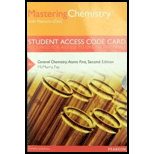
Concept explainers
(a)
Interpretation:
From the given
Concept introduction:
Molecular orbital theory:
Molecular orbital theory describes molecules in electronic structure. Electrons are moving around nuclei in entire molecule. Atomic orbitals in which electrons present in one atom. Molecular orbitals in which electrons are present in more atoms. Bonding and anti-bonding orbitals are found in molecular orbital theory.
(b)
Interpretation:
From the given transition metals, one with lowest melting point has to be explained.
Concept introduction:
Molecular orbital theory:
Molecular orbital theory describes molecules in electronic structure. Electrons are moving around nuclei in entire molecule. Atomic orbitals in which electrons present in one atom. Molecular orbitals in which electrons are present in more atoms. Bonding and anti-bonding orbitals are found in molecular orbital theory.
(c)
Interpretation:
The ascending order of hardness of given transition metals has to be explained.
Concept introduction:
Molecular orbital theory:
Molecular orbital theory describes molecules in electronic structure. Electrons are moving around nuclei in entire molecule. Atomic orbitals in which electrons present in one atom. Molecular orbitals in which electrons are present in more atoms. Bonding and anti-bonding orbitals are found in molecular orbital theory.
Want to see the full answer?
Check out a sample textbook solution
Chapter 21 Solutions
Masteringchemistry with Pearson Etext -- Standalone Access Code Card -- For General Chemistry
 ChemistryChemistryISBN:9781305957404Author:Steven S. Zumdahl, Susan A. Zumdahl, Donald J. DeCostePublisher:Cengage Learning
ChemistryChemistryISBN:9781305957404Author:Steven S. Zumdahl, Susan A. Zumdahl, Donald J. DeCostePublisher:Cengage Learning ChemistryChemistryISBN:9781259911156Author:Raymond Chang Dr., Jason Overby ProfessorPublisher:McGraw-Hill Education
ChemistryChemistryISBN:9781259911156Author:Raymond Chang Dr., Jason Overby ProfessorPublisher:McGraw-Hill Education Principles of Instrumental AnalysisChemistryISBN:9781305577213Author:Douglas A. Skoog, F. James Holler, Stanley R. CrouchPublisher:Cengage Learning
Principles of Instrumental AnalysisChemistryISBN:9781305577213Author:Douglas A. Skoog, F. James Holler, Stanley R. CrouchPublisher:Cengage Learning Organic ChemistryChemistryISBN:9780078021558Author:Janice Gorzynski Smith Dr.Publisher:McGraw-Hill Education
Organic ChemistryChemistryISBN:9780078021558Author:Janice Gorzynski Smith Dr.Publisher:McGraw-Hill Education Chemistry: Principles and ReactionsChemistryISBN:9781305079373Author:William L. Masterton, Cecile N. HurleyPublisher:Cengage Learning
Chemistry: Principles and ReactionsChemistryISBN:9781305079373Author:William L. Masterton, Cecile N. HurleyPublisher:Cengage Learning Elementary Principles of Chemical Processes, Bind...ChemistryISBN:9781118431221Author:Richard M. Felder, Ronald W. Rousseau, Lisa G. BullardPublisher:WILEY
Elementary Principles of Chemical Processes, Bind...ChemistryISBN:9781118431221Author:Richard M. Felder, Ronald W. Rousseau, Lisa G. BullardPublisher:WILEY





